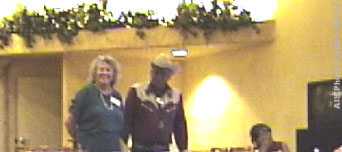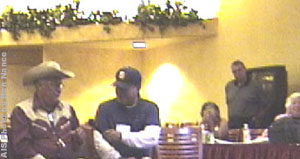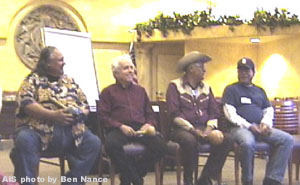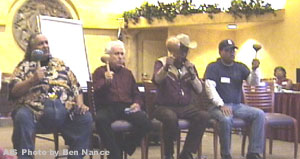Advocates for
Indigenous California Language Survival Workshop at Barona
By Roy Cook
 Leanne
Hinton, PhD Linguistics professor from Berkley, opens the Saturday, June
7, 2003, afternoon session. The meeting is held in the Barona tribal council
chamber next to the Barona Museum. The days have been overcast and very
much what is described in San Diego as June gloom. Inside the room it
is bright and hot. Illumination, brilliance and points of light shine
in the brown faces all around the tables. This is a powerful group of
dedicated individuals, Yuman, Cahuilla, Serrano, Tule River, and other
tribes, committed to the survival of tribal languages.
Leanne
Hinton, PhD Linguistics professor from Berkley, opens the Saturday, June
7, 2003, afternoon session. The meeting is held in the Barona tribal council
chamber next to the Barona Museum. The days have been overcast and very
much what is described in San Diego as June gloom. Inside the room it
is bright and hot. Illumination, brilliance and points of light shine
in the brown faces all around the tables. This is a powerful group of
dedicated individuals, Yuman, Cahuilla, Serrano, Tule River, and other
tribes, committed to the survival of tribal languages.
 The
Master – Apprentice language learning program is evaluating the conversational
proficiency of the language learner and perhaps sensing the level of repetition
burnout that might threaten the “master’ native speakers. From the time
of European contact, there were almost 100 languages spoken in California
alone over half are no longer heard. All are threatened; many only have
a handful of speakers left. The challenge is great but the rewards are
evident and powerful. It feels real good to be here.
The
Master – Apprentice language learning program is evaluating the conversational
proficiency of the language learner and perhaps sensing the level of repetition
burnout that might threaten the “master’ native speakers. From the time
of European contact, there were almost 100 languages spoken in California
alone over half are no longer heard. All are threatened; many only have
a handful of speakers left. The challenge is great but the rewards are
evident and powerful. It feels real good to be here.
Kasaw! It is time to eat.
A delightful session of exercises in non- verbal communication is introduced. Cards with instructions are distributed and one person must convince the next to do something involving a task or movement. Some are humorous. Others are instructive and to the point. All learn the possibilities and enjoy the antics of the ones receiving the instructions. Great fun! Ernie Siva from Morongo and Preston Arroweed, from Quechan, took their instructor roles with great delight. It is so empowering to experience traditional education even if the model is standard textbook. “The trick is to do things as you are learning your language.” Said Leanne Hinton, “Total Physical Response basic premise involves movement, as we repeat the same movement we recall the language associated with that motion.” Drills continued that would require someone to act or do something active. Jane Dumas and Lee Acebado, M & A, are sitting together and next to me as I receive a card with instructions to get some one to bring me a cup of coffee. Jane smiles as Lee returns with a hot cup of coffee for me. There are more smiles and laughter all around the room. It is such a delight to be in a learning environment that is not stressful or authoritarian.
Cheryl Hinton, curator of the Barona Museum, is moving around the room smoozing and enjoying the diversity of the workshop participants. There are attendees from Barona and out of the state and even some from Baja. The survival of Tribal language is a compelling reason to participate and learn new techniques. Cheryl escorts a break out session over to the museum. Instructions continue in smaller groups. This allows for more participation and involvement. The intensity is heightened; you can almost feel and smell the electricity in the air. Folks need to step outside, from time to time, to feel the cool Barona breeze on their face. It is exciting.
Later in the afternoon Leanne reviews steps to organize a language program in tribal communities. She calls upon the participants to relate their individual experiences in California and Arizona. It is good to see Richard Bugbee, Luiseno, he is a board member of the Advocates. He arranged the AICLS training at Barona. Mariana Drummond, Director of the program is also here. To contact the Advocates for Indigenous California Language Survival, write AICLS, 1215 66th St. Berkeley, CA 94702 (510) 655-8770. Also it is nice to see, Karen Vigneault, Ipai, as she is filming all the sessions for the AICLS archives.

![]() Finally,
it is time for AICLS board member Jon Meza Cuero, Tipai, to present Nymie/Wilcat
songs to the group remaining. Jon related his background as a singer and
native speaker. He spoke in Tipai, Mexican/Spanish and English. He introduced
his long time M/A student Stan Rodriguez, Ipai and two other students,
Ben Nance and Roy Cook, Opata/Osage. I point out the value of learning
the language through song. Proper pronunciation of words and reinforcement
of learning is a constant benefit each time the song is sung.
Finally,
it is time for AICLS board member Jon Meza Cuero, Tipai, to present Nymie/Wilcat
songs to the group remaining. Jon related his background as a singer and
native speaker. He spoke in Tipai, Mexican/Spanish and English. He introduced
his long time M/A student Stan Rodriguez, Ipai and two other students,
Ben Nance and Roy Cook, Opata/Osage. I point out the value of learning
the language through song. Proper pronunciation of words and reinforcement
of learning is a constant benefit each time the song is sung.

Jon leads a hot set of Wildcat songs that get many listeners moving and
tapping their feet. With smiles all around the Saturday afternoon session
is brought to an end. We break for dinner and perhaps stories or more
songs later in the evening or tomorrow at the final AICLS session. Mehan.
americanindiansouurce.com
Roy Cook: writer, public relations, speaker
Opata/Osage-Mazopioye Wichasha
WebMaster: Ben Nance